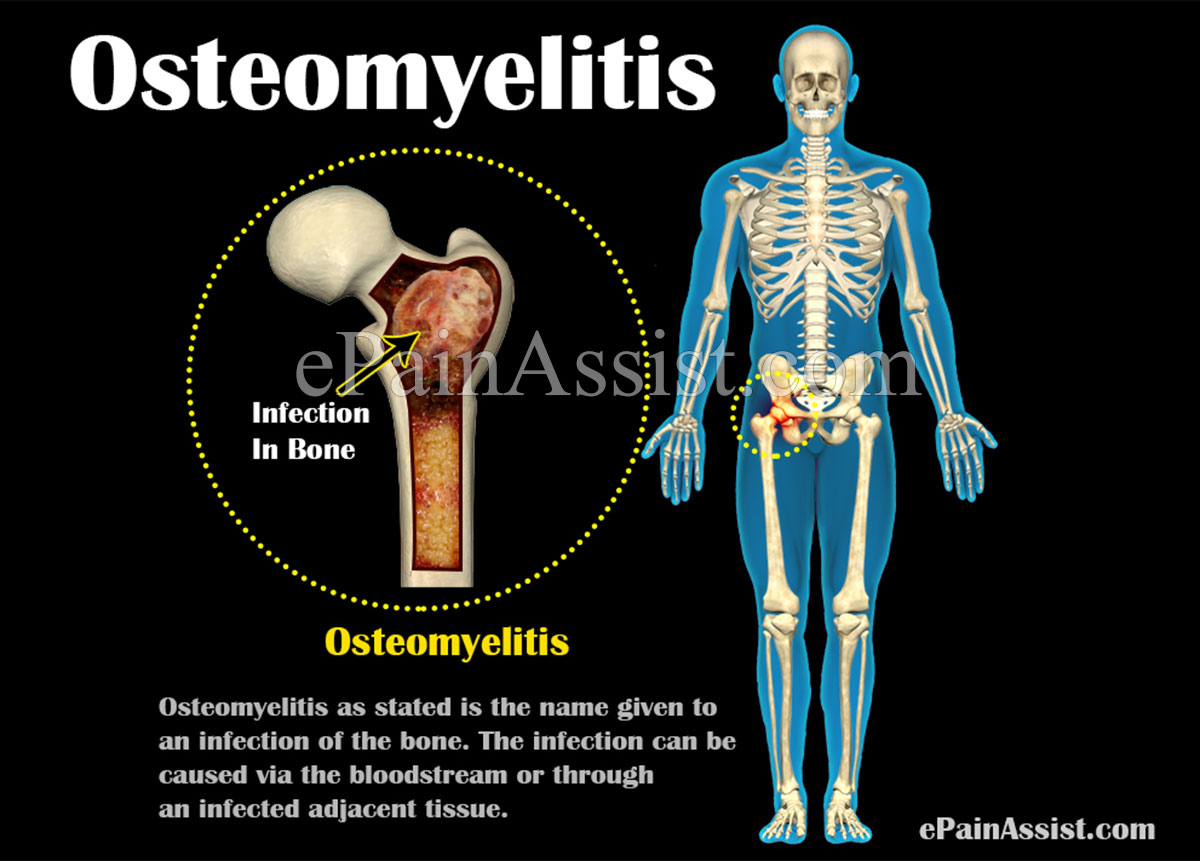Osteomyelitis– This is the name given to an infection of bones. In this condition, the bones may get infected through blood or through an adjacent infected tissue. This condition may also be caused due to an injury to the bone with the bone getting infected.

What Is Osteomyelitis?
Osteomyelitis as stated is the name given to an infection of the bone. The infection can be caused via the bloodstream or through an infected adjacent tissue.1 An injury to the bone causing infection may also be a cause of Osteomyelitis. In majority of children, Osteomyelitis affects the long bones of the body which are the legs and the upper arm whereas in the adult population Osteomyelitis mainly affects the spine. Diabetics may develop Osteomyelitis in the feet in case they are suffering from ulcers of the foot. Osteomyelitis is a treatable condition. Majority of the affected people require surgical procedures to excise the bones which have been affected followed by administration of antibiotics for some time.
What Are The Causes Of Osteomyelitis?
Osteomyelitis Can Be Caused By The Following Ways:
Blood: Osteomyelitis is mainly caused through blood. Infection from other parts of the body traverse through the blood and affect a weak area in the bone and make it infected. In children, Osteomyelitis usually affects the growth plates which are considered to be the weaker area of the body.
From Adjacent Infections: In case if an individual has an injury to an area that gets infected, then it may also cause Osteomyelitis in the adjacent bones.
Contamination: This may happen in cases where an individual has suffered a severe injury where the bone of the body becomes exposed outside the skin. Contamination can also take place during surgical procedures for joint replacement or fractures.
What Are The Risk Factors For Osteomyelitis?
Some Of The Risk Factors For Osteomyelitis Are:
A Recent Injury Or A Surgical Procedure Of The Bones: A severe bone fracture or a surgical procedure makes the bones prone to infections and there is high risk of contamination.
Circulation Disorders: Certain circulation abnormalities can also result in Osteomyelitis. Some of the medical conditions that impair the blood circulation are:
- Inadequately controlled diabetes
- Peripheral arterial disease
- Sickle cell trait
In case if the immune system of the body gets affected by an underlying medical condition then there is an increased risk for development of Osteomyelitis. Some factors which affect the immune system of the body are:
- Chemotherapy
- Inadequately controlled diabetes
- Organ transplantation
- Chronic use of corticosteroids
Apart from the above mentioned risk factors, using non-sterilized injection needles can also cause Osteomyelitis.
What Are The Symptoms Of Osteomyelitis?
Some Of The Symptoms Of Osteomyelitis Are:
- Fever 1
- Chills 1
- In cases of children, there will be fatigue and irritability
- Pain at the site of the infection
- Swelling and redness at the site of infection
How Is Osteomyelitis Diagnosed?
Osteomyelitis Is Diagnosed By The Following Ways:
Blood Tests: This test may reveal elevated white blood count signifying infection.2 It may also reveal other potential factors which will point to the fact that the body currently is battling an infection. In case Osteomyelitis is caused due to infection from the blood then the germs involved in the infection can be determined with blood tests. In case if Osteomyelitis is suspected with blood tests, then other studies and investigations may be ordered.
Radiographic Studies:
X-rays: This will help identify any damage caused to the bone. However, if Osteomyelitis is in the initial stages, then the x-ray may be reported as normal and more invasive studies may be required like CT scan and MRI studies to look at the structure of the bone and surrounding tissues and also to look for any potential damage to the internal structures.
Bone Biopsy: A bone biopsy is the primary study for a confirmatory diagnosis of Osteomyelitis, as it will give the type of germ infecting the bone and allow the treating physician to formulate an adequate plan for treatment.2
What Are Treatments For Osteomyelitis?
The treatment for Osteomyelitis is basically three fold which involves medications, surgery, and therapy.
Medications: As the bone biopsy will identify the germ causing the infection, the treating physician will prescribe the appropriate antibiotic to fight the infection. The antibiotics are given intravenously for a period of at least six weeks so that the infection completely resolves. Some of the side effects of antibiotics can be nausea, vomiting or in some cases diarrhea.
Surgical Procedure: Based on the severity of Osteomyelitis, the following procedures may be carried out:
- Draining of infected area- In this procedure, the infected area is explored and is drained of any fluid or pus.
- Debridement of infected bone or tissue- In this procedure, the infected bone or tissue is completely removed from the body.
- Amputation- This is the last resort in which the infected limb is removed from the body completely to stop the infection from progressing further.
Therapy: A treatment called as hyperbaric oxygen therapy is given to individuals who have severe Osteomyelitis which is difficult to treat with standard methods. This therapy allows more oxygen to bone and promotes healing.
How Can Osteomyelitis Be Prevented?
To prevent Osteomyelitis, the individual needs to be aware of potential infections that can be caused and hence it is imperative that the individual seeks immediate medical attention in cases of any injury to the bone or fractures etc. Prevent germs from entering the body by cleaning even small scrapes or cuts by applying sterile bandage.
Also Read:
